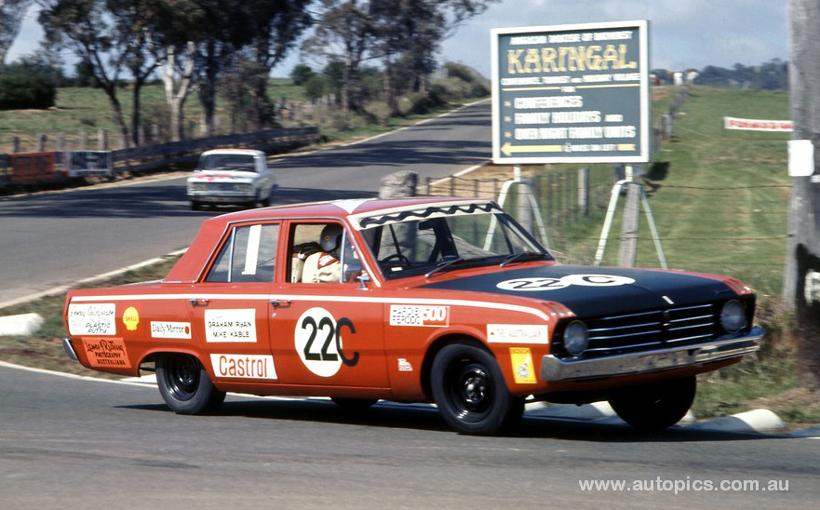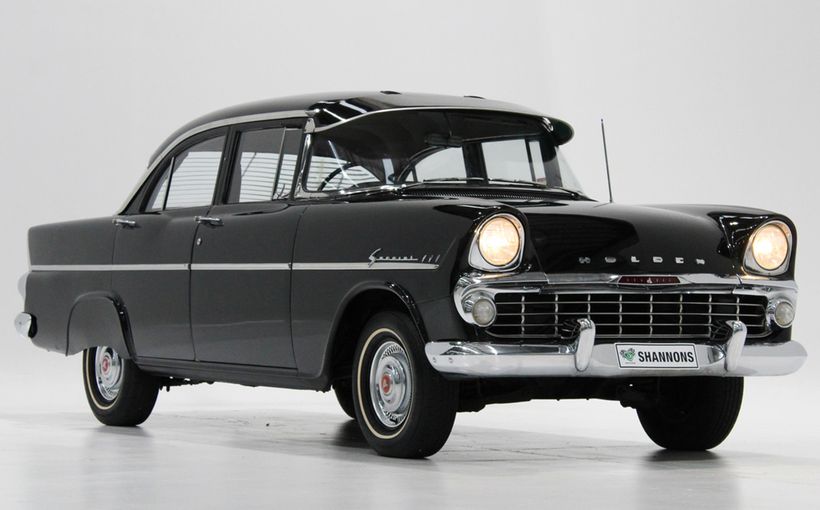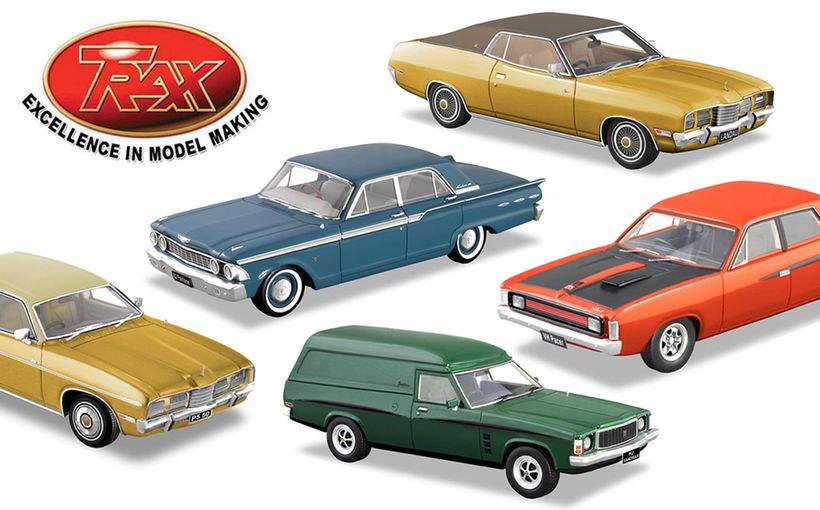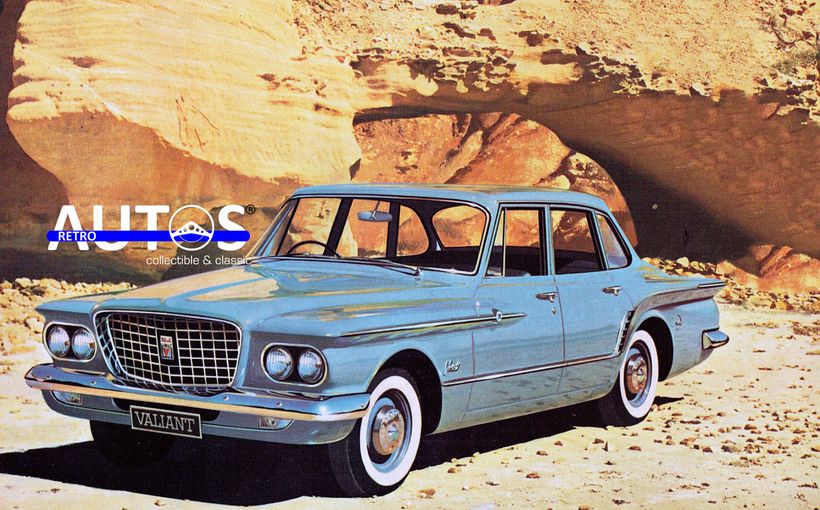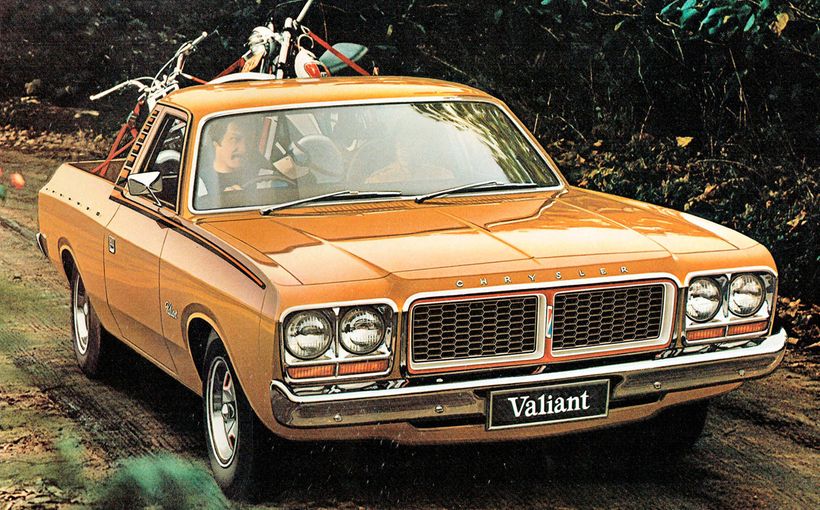VF Valiant Pacer 225: The Sports Sedan that set Chrysler’s pulse racing
By
MarkOastler -
30 March 2015

Works driver Graham Ryan manhandling the VF Pacer 225 through Murray’s Corner at Mount Panorama in 1969. This was the original slant six Pacer’s first and only appearance at the Hardie-Ferodo 500, as the hotter and faster Hemi-powered VG model was waiting in the wings for 1970. Note how the passenger seat was fully reclined so that the large tombstone-style bucket seat would not obscure the drivers’ vision through the kerb-side windows.
“It would be fair to say that the VF Pacer was the first Valiant that opened Chrysler Australia’s eyes to the benefits of being directly involved in motor sport,” former competitions boss John Ellis told Shannons Club. “It led to more investment and participation by the factory and ultimately the
Hemi Pacer and
R/T Charger programs.”
Not that the Pacer was the first Valiant seen on Australian race tracks. In the early to mid-1960s, drivers like Ern Abbott, Clem Smith and Des Leonard were tearing up the tracks in
R series Valiants which under the Appendix J touring car rules allowed modifications to their slant six engines to improve performance.
Those early cars performed extremely well against more powerful pace-setters like Bob Jane’s 4.2 litre Jaguar Mk II and Norm Beechey’s monstrous 409 cid
Chev Impala. Even so there was no interest from Chrysler Australia in directly supporting these drivers, despite the enthusiastic army of supporters their cars attracted.
The R and S series Valiants also competed in the early years of the annual Armstrong 500-mile race for stock standard road cars at Phillip Island and Bathurst. Later models enjoyed Class D wins at the Mountain, including the AP5 in 1963 and the
VC V8 model in 1966 which scored a resounding 1-2. Again, these excellent results were achieved by private or dealer-backed cars with no factory support.
Then in March 1969, Chrysler launched its new budget-priced VF Pacer, designed for young drivers (and those young-at-heart) who wanted a sporty but practical four door sedan that didn’t cost the earth to own and insure.
It was powered by a unique high compression 175 bhp version of the corporation’s venerable 3.7 litre (225 cid) slant six, which at the time was the most powerful six cylinder engine made in Australia. Its plentiful low-down torque and spirited acceleration produced sub 18-second standing quarters, although hindered on starts by the relatively tall 2.95:1 first cog in its three-speed gearbox.
With a manual floor shift, lowered suspension, front anti-sway bar, tachometer, special wheel covers, racing stripes, decals and a choice of bright colours, it was an excellent all-round performance package for the money.

Leo Geoghegan’s VF Pacer leading Fred Gibson’s works XW Falcon GT-HO at Queensland’s Surfers Paradise Raceway during the hotly contested Tasman Touring Car Series round held there early in 1970. This new format supported the annual Tasman Series for open wheelers and produced some great racing.
Outwardly at least, the corporate mood towards motor sport had not changed when the Adelaide-based firm launched the Pacer. However, things had changed dramatically on the race track since the hot-rodded R series Valiants of the Appendix J era.
The Bathurst 500 had enjoyed a rapid spike in public interest and by the late 1960s this annual event was proving influential in purchasing decisions made by new car buyers. A win, either outright or in one of the classes, was translating to increased showroom traffic after the race.
Also alerting Chrysler to the possibilities in Series Production racing were pentastar loyalists like Melbourne Chrysler dealer Jack Nougher (aka Eiffeltower) and his sales manager David O’Keefe.
They were punting the VF Pacer on local circuits and although outgunned by the faster and more powerful Falcon GTs and GTS Monaros of the era, the Valiants were far from disgraced. Just seeing them competing against market rivals Ford and Holden on the track started to raise the pulse rate at Chrysler HQ.
Company boss David Brown could see the benefits of being directly involved, not only through increased showroom sales but also putting a spring in the step of every employee swept up in the team spirit that comes with such programs. He was also aware that there was considerable enthusiasm for motor sport throughout the company, particularly amongst young engineering staff.
Given the corporate change of mood, Chrysler’s Sydney-based national service manager Brian Butler approached none other than Leo Geoghegan about becoming involved in the Pacer motor sport program.
Even though Butler was a good friend of the Geoghegan family, it took a fair degree of arm twisting to get Leo to come aboard given that he was one of the country’s finest racers and had more to lose than gain from driving an uncompetitive car.

Hard to believe two cars so different in size and mechanical design could be class competitors! Back in the golden days of Series Production racing, when cars were grouped according to their showroom prices, such contrasts were not unusual. Here Graham Ryan in the Blue Point Motors VF Pacer is fending off Les Grose’s Mini Cooper S at Catalina Park in 1970. This fast, demanding circuit at Katoomba in the NSW Blue Mountains was like a mini-Nurburgring and a great loss to the sport when it closed.
Leo was also busy racing Lotus sports cars and open wheelers with great success and selling road going versions of the famous British marque through a thriving dealership he ran with his younger brother Ian (Pete). As a result, Pete also dabbled in some early track testing of the Pacer, even though he was contracted to Ford and king of the Improved Production class in his V8 Mustangs at the time.
“My first encounter with a racing Valiant was at Oran Park in a VF Pacer,” wrote Pete in his introduction to ‘Chrysler Valiant’ by Marque Publishing. “Brian Butler was responsible for putting the test session together and brought a couple of Chrysler people along to have a look at how the car went.
“It was pretty good from the start but we carried out some extra work to improve the car. What we really needed was a four-speed gearbox, but Borg Warner didn’t do one at the time. The regulations went on about Australian content so we couldn’t import a suitable ‘box.
“John Ellis was the chief engineer for the program and not only worked at making the Pacer better, but also at looking at the regulations to see how the car could be improved and still stay within the law.”
Leo found the new Pacer ponderous; not surprising given that he usually raced some of the fastest and best handling competition cars in Australia. Even so, he agreed to be involved as the idea of getting in on the ground floor of a new factory-backed racing program was of great interest.

Leo Geoghegan in the VF Pacer on debut at Catalina Park in mid-1969. From these humble beginnings, Geoghegan’s role in the development of the VG Hemi Pacer and later R/T Charger would grow significantly. His younger brother Ian also drove the slant six Pacer on occasions.
Improving the breed
Early race track development of the VF Pacer was carried out by Geoghegan and Adelaide-based Ian Cook, who not only raced open wheelers but also worked for Chrysler Australia as a test and development driver of considerable skill.
Cook was involved in determining the VF Pacer’s initial road-going specification, ensuring that engine and braking performance were properly matched and that ride heights, sway bars and shock absorbers produced the right balance of handling safety and performance.
When the decision was made to go racing, the company’s testing schedule was expanded to ensure the Pacer could deal with the extremes of competition use.
An important initial test occurred in 1969 at Melbourne’s Sandown Park. Despite some awful weather, two Pacers shared by Jack Nougher/David O’Keefe and Des West/Ted Brewster ran non-stop for 12 hours and broke numerous distance records. Unfortunately their achievements were not officially recognised by the Confederation of Australian Motor Sport (CAMS) on a technicality, but for Chrysler Australia it was a valuable test session.
Another non-stop 12 hour run was held at Mallala Raceway near Adelaide. This was a much tougher assignment than Sandown, as the South Australian track’s tighter and more demanding layout was a brutal test of tyres, handling and braking.
The Pacer immediately showed a strong tendency to understeer, so they put more negative camber on the front wheels and dropped the front ride height to lower the centre of gravity. These changes, along with an increase in tyre pressures (45-50 psi) to reduce tyre wall distortion resulted in more front end grip and sharper steering response.

Leo Geoghegan leads one of the works XW GT-HOs through Creek Corner at Sydney’s Warwick Farm Raceway, during the 1970 Tasman Touring Car Series. This photo shows how the Pacer was often a victim of unfair performance comparisons by the uninitiated, due to it being similar in size to the 5.8 litre V8 Falcons but powered by a much smaller 3.7 litre inline six. The speed disparity (particularly on TV) was a difficult misconception for Chrysler to overcome and did the Pacer no favours.
The Mallala test also produced fade in the shock absorbers due to overheating. To cure the problem, Chrysler engineers produced a heat-resistant nylon ring for the internal piston to stop oil leaking past the piston for better suspension control. This was a good example of racing improving the breed, because shocks fitted with the new nylon ring soon became standard fitment on all Chrysler production cars.
Another weakness emerged after about 10 hours, when a front wheel bearing failed. A replacement was fitted to allow the car to reach the 12 hour target. Although it was the same bearing that had been fitted to all previous Valiants without a hint of trouble, engineers worked out that the load on the bearing had been up to ten times greater than normal road use.
This was due to the higher cornering speeds, heavier braking loads and increased grip levels of the latest high performance tyres. It was decided that a larger bearing would solve the problem, so a new factory specification was issued and the bigger front wheel bearings were then used on all Valiants. Another example of racing improving the breed.
Braking performance also came under scrutiny at Mallala. The optional 279mm solid front disc brakes provided good stopping power, but were prone to heat-related fade on the track. There was not a lot that could be done to improve their efficiency, apart from fitting harder pad materials.
The self-adjusting mechanisms on the rear drum brakes were also removed for racing, because the adjusters would ‘chase’ the drums outwards as they expanded due to extreme heat. This caused the brake shoes to run too close to the friction surface, causing even higher temperatures and rapid wear. The cars also raced without a power booster, to improve brake pedal feel.
It’s interesting to note that at some stage during this process, the Geoghegans were involved in a ferociously fast ‘what if?’ project to see what was possible, according to Pete Geoghegan.

Fred Gibson in the works XW Falcon GT-HO leads Graham Ryan’s VF Pacer during the Tasman Touring Car Series round at Surfers Paradise early in 1970. Ryan had considerable involvement in Chrysler’s racing program, narrowly missing out on a class win and third outright in a works VG Hemi Pacer with Doug Chivas at Bathurst later that year. If not for a flat tyre on the second last lap, they would have finished on the podium.
“I also test drove a Falcon GT-HO and it went hard, but the Valiant VF that we built up with a 360 cubic inch (V8) motor and imported four-speed gearbox went like hell. I’m sure it would have shaken the ‘HO, but never saw the light of day (in terms of series production).”
Given that the 360 cid version of Chrysler’s A series small block V8 didn’t arrive until 1971, it’s likely Pete was getting confused with the shorter stroke 340 cid version of that engine when recalling these events in 1996 - more than a quarter of a century later.
In any case, just the fact that such a prototype was built and tested (was he talking about the ‘stubby’ ute test mule or another top secret prototype?) gives an indication of how seriously Chrysler wanted to play with the big boys and were exploring all options.
Brian Butler, who knew the company’s new ‘Hemi’ six was due in 1970 but sworn to secrecy at the time, moved to sign up some other top driving talent with a view to Chrysler’s increasing involvement in the sport.

More great action from Catalina Park in early 1970. Graham Ryan leads Garry Cooke’s rotary-powered Mazda R100 and Les Grose’s Mini Cooper S through the notorious Craven A corner in a typically close and entertaining Class C battle. This tricky corner with its tightening radius and unforgiving wooden barriers claimed many victims.
These included the hard-charging Graham Ryan, the versatile genius of Doug Chivas, renowned Holden touring car star Des West and even Stormin’ Norm Beechey, who showed his faith in the brand by adding a Chrysler dealership to his many business interests.
According to noted historian Gavin Farmer, Chrysler’s track campaign was officially launched at Catalina Park on June 15, 1969 when Leo Geoghegan debuted the new VF Pacer. The car was not as well suited to the Katoomba circuit’s notorious twists and turns as the swarm of menacing Minis he tried to swat out of the way.
Even so, Leo was having a real go until the heavily loaded right front wheel cracked, forcing him to pit for a wheel change. Interestingly, Geoghegan would suffer a similar failure at Oran Park in 1970 while leading the first race contested by the new VG Hemi Pacer.
“One of the most valuable lessons we learned from racing the Pacer was that a standard steel wheel designed for road use was no longer strong enough to cope with the cornering loads in racing, particularly with the extra grip being generated by the latest racing tyres,” John Ellis told Shannons Club.
“It forced Chrysler to look for the best solution for the upcoming R/T Charger and that was to switch to a (single-cast) alloy wheel which was not only stronger but also much lighter with better brake cooling. We were running alloy wheels long before Ford and Holden were.”

The VF Pacer entered by Melbourne Chrysler dealer Jack Eiffeltower (aka Nougher) and his sales manager David O’Keefe led home a Chrysler quinella in Class C at the 1969 Datsun 3-Hour race at Sandown Park. Note how the tall passenger seat with its integral head rest was reclined down onto the back seat, to improve peripheral vision. Pacer drivers often did this.
1969 Sandown 250 and Bathurst 500: A toe in the water
Apart from the shock absorber and front wheel bearing failures, the VF Pacer had run reliably and trouble-free during its 12 hour tests which gave Brian Butler the confidence to back two of them in the Bathurst curtain raiser that covered a much shorter distance – the 1969 Datsun 3-Hour race.
The two Pacers, entered by Eiffeltower Motors at Dandenong, were shared by the proven combination of Jack Nougher/David O’Keefe in one car with new signing Des West joined by Glyn Scott in the other. These semi-works cars were backed by two dealer-entered VF Pacers for Bob Brown/Ted Brewster (Max Manley Motors) and Adelaide Chrysler stalwart Clem Smith (Clem Smith Motors).
The two Eiffeltower cars outclassed several S-type Mini Coopers and a lone XT Falcon V8 to finish first and second in Class C, a full lap ahead of the third-placed Falcon. Although competitive in its price division, it’s sobering to note that the VF Pacer finished six laps behind the works-entered Falcon GT-HO driven by Allan Moffat/John French to outright victory.

The second Eiffeltower VF Pacer shared by Des West and Glyn Scott finished runner-up in Class C at the 1969 Datsun 3-Hour at Sandown. West would star for Chrysler in the faster four-barrel VG Hemi Pacer he shared with Peter Brown at Bathurst in 1970, leading the race outright at one stage and winning Class D by a whopping six laps.
Surprisingly perhaps, the Sandown-winning Eiffeltower cars did not make an appearance at Bathurst three weeks later. Only one VF Pacer was on the grid for the 1969 race, shared by Graham Ryan and motoring journalist Mike Kable.
The huge 63-car field was broken up into five competing classes (A to E) based on retail prices. Class C ($2251-$3100) promised to be a real slug-fest between the VF Pacer and a fascinating mix of showroom rivals including the dominant S-type Mini Cooper,
Fiat 125, Ford Capri 1600 GT, Renault 16 TS and the new rotary-powered Mazda R100.
The Pacer faced a formidable challenge in trying to topple the mighty
1275cc Mini Cooper S, given the famous ‘brick’ had won Class C four years straight including its historic outright win in 1966.
With a 1340 kgs kerb mass, the Pacer was a much larger and heavier car by comparison, with an inferior power to weight ratio and handling and braking that could not match the go kart-like response of the sub-700 kgs Cooper S. The new Valiant was also an unknown quantity at Bathurst, with fuel consumption, tyre and brake wear yet to be determined over 500 miles (800 kms) of racing.

The VF Pacer’s racing career was relatively brief, as the factory’s competitive focus was on the Hemi-powered VG model due in 1970. Most VF Pacer racers were dealer-backed entries, like the cars entered by Bob Brown (above left) and Valiant stalwart Clem Smith at the 1969 Datsun 3-Hour at Sandown Park.
The Pacer’s Bathurst debut showed promise when Graham Ryan qualified third fastest in Class C with a best time of 3 min 12.4 secs. That was only 0.4 sec slower than the second fastest Mini and within 1.5 seconds of the quickest Cooper S of John Prisk/Alan Cameron on pole position.
Unfortunately the Class C pole-sitter and about a quarter of the field became entangled in the infamous first lap pile-up triggered by Bill Brown rolling his Falcon GT-HO at Skyline. The multi-car crash claimed many mechanical victims, but somehow the Pacer managed to make it through the wreckage unscathed.
The Valiant sedan proved to be one of the top class contenders, leading at various stages throughout the race in a see-sawing battle with the fastest S-type Coopers and some very quick Fiat 125s. The big picture though was that the Pacer had a bigger appetite for tyres and front brake pads than its smaller foes and was losing too much time in the pits changing them.
After an enthralling day-long battle which saw the top three cars finish on the same lap, the Class C victory went once again to a Cooper S with two Fiat 125s chasing the Mini home in second and third places. In fourth (18th outright) was the VF Pacer, one lap down but running strongly when it took the chequered flag.

The VF Pacer shared by Graham Ryan and Mike Kable takes the chequered flag to finish fourth in Class C at the 1969 Hardie-Ferodo 500. The sporty Chrysler sedan faced an uphill battle (literally) against smaller and more agile class competitors, like the dominant Mini Cooper S and Fiat 125.
The 1969 Bathurst race had given the Chrysler boys some valuable insights into the Pacer’s performance at Mount Panorama. The lack of any major mechanical problems, particularly in chassis and suspension, would also have given them a confidence boost as the company’s motor sport focus switched to the hotter 245 cid Hemi six-powered VG model due for release in April 1970.
VF Pacers continued to compete during the remainder of 1969 and into the early months of 1970, including rounds of the new Tasman Touring Car Series, before the new Hemi- powered models became available. These outings included the 1969 Southern Cross Rally with the versatile Doug Chivas completing the arduous event in a largely stock VF Pacer with minimal rally preparation.
With the release of the new VG range in April 1970, the VF Pacer’s days as a track racer were at an end. However, in local motor sport history it was a pivotal car. It not only sparked Chrysler’s motor sport involvement but also served as an invaluable development mule for the VG Hemi Pacer and R/T Chargers that followed. The VF Pacer’s important legacy should never be forgotten.












